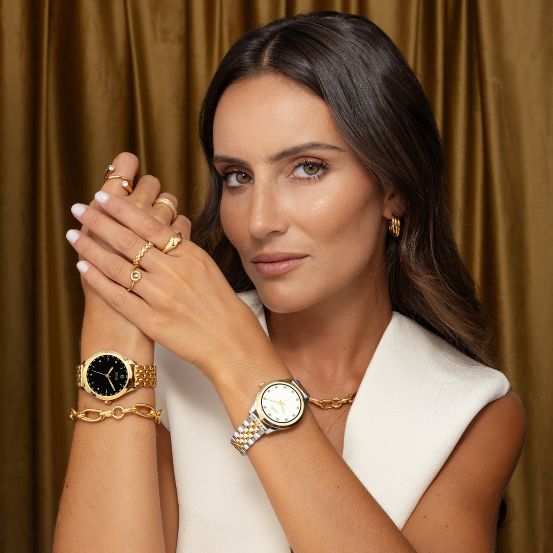No, I'm not blushing. I didn’t have a little wine. I’m not feeling hot or feverish. And I would appreciate it if you’d stop commenting. This is the story of those who try to turn the other cheek, even when it also mirrors the symptoms of something that is not ok.
No, I'm not blushing. I didn’t have a little wine. I’m not feeling hot or feverish. And I would appreciate it if you’d stop commenting. This is the story of those who try to turn the other cheek, even when it also mirrors the symptoms of something that is not ok.
Rosacea is not the name given to those who blush very easily. Rosacea is also not a symptom of those with sensitive and reactive skin. Rosacea is not a new condition, but it is estimated that the number of people with this problem is increasing - and that might be due to stress, the use of masks, and another handful of reasons. Rosacea is more than a skin disease that is difficult to hide, it is a cause of discomfort, pain, and problems of self-esteem for those who suffer with it and see, as an adult, their skin changing - and right on their postcard to the world. In the Portuguese skinstagram - the part of this social network that talks about everything related to skincare and beauty routines - it is hard to talk about rosacea without mentioning Sara Fernandes (@makedown_) who, between colorful makeup looks and a scientific approach to skincare due to her background, since she is a pharmacist with a specialization in cosmetic sciences, she also shares a little bit of her rosacea diary, documenting the worst of its crises and what she does to control them.
Although it is not a new pathology, there is still a lot to discover about its causes and about what it actually is, the specialist tells us: “Rosacea is a chronic and inflammatory condition, whose etiology and pathology is not yet completely known. There are no biochemical or serological (common biochemical analyzes) criteria to confirm the diagnosis of rosacea, which is mostly done by observing morphological characteristics and the complaints that the patient has. To date, concrete causes of the disease have never been identified. It is known to be more prevalent in women and Caucasians, but that does not exclude men and other ethnicities who, precisely because they are less frequently affected by it, often find their treatment options limited (for example almost all products have a greyish or greenish color to cancel the pink or red, which leaves a ghostly effect on darker skin tones). There is also the involvement of the Demodex parasite, which, under normal circumstances, lives at peace with us, but in patients with rosacea gets out of control. Some small studies even mentioned that there may also be an intestinal involvement. Unfortunately, and so far, there are more questions than answers ”. From what has already been studied, we also know that there are four types of rosacea, “erythematotelangiectatic, papule-pustular or acne rosacea (often misdiagnosed as acne vulgaris), fimatosa (can lead to rhinophyma and a change in the structure of the skin) and ocular rosacea” explains Sara, “however, this categorization is not universal among themselves because these types of rosacea are not linear or 'static'. That is, a patient can have the first 2 types and the ocular. The evolution of the disease is also not linear between states and it both evolves and progresses ”. As for the symptoms, in their initial phase, they may not be easy to detect. The most common is the feeling of heat and tenderness on the face, flushing, itching, pustules, and redness (or erythema) with telangiectasias (visible blood vessels). The fact that not much is known about rosacea also ends up contributing to the misinformation associated with confusing diagnoses and even worsening the problem with inadequate treatments.
“It is not a curable disease and is characterized by stable and crisis periods'', describes Sara. If so, is it possible to control and manage these crises? Sara answers: “The answer to this question is it depends. It depends on the extent and state of the rosacea and what is considered to be controlling it. Some people will be able to keep their skin healthy just by using some cosmetics, others will have to use medicine such as antibiotics (which is a subtherapeutic dose that have a vasoconstrictor effect), anti-fungal (to control the evil Demodex); heart rate modulators, and even some medicated ointments (with anti-fungal drugs or vasoconstrictors). Other people will already have an extension of erythema or redness that can only be reduced with the use of some types of laser”. In cases of less aggravated rosacea, skincare will be a key ally. “The routine must be based on good cleansing, good hydration, and competent sun protection that does not aggravate the problem. The first step should be a gentle cleanse with something like Sensibio (Bioderma) or the Hydrating Cleanser by Cerave. To hydrate, you could use a serum like the Redness Neutralizing serum by Neostrata or the Leti SR serum, and if you need some extra hydration I personally love Physiogel AI for combination and dry skin (in wintertime) and Sensifine AR by SVR for oilier skin types (in summertime). Regarding SPF, it is a little bit tricky since many filters worsen rosacea and for me, the textures of mineral sunscreens are just awful. The best ones I have used so far are the UV safe me sun gel by Make Pr:em (a Korean brand) Aquafluid by ISDIN. I also keep nearby some SOS products that help me deal with some more serious crises like thermal water (any of them should do the trick), Serozinc by La Roche-Posay, and the Very Simple Pack patches by Cosrx that are amazing to use under the mask”, explains Sara. But she also warns us that every skin is different and so is each case of rosacea. There are some general rules to follow, but we are still in a gray area regarding specific ingredients. “It is always a little bit of a Russian roulette because there are no universal or well or poorly tolerated ingredients, but when the person has active erythema, I would say to avoid products with perfume, essential oils, and exfoliating ingredients such as alpha and beta hydroxyacids. However, some treatment guidelines indicate that the use of retinoids can be beneficial, the big problem is finding one that the patient can tolerate. In general, opt for neutral creams, which give comfort to the skin and designed for skin with rosacea”, she explains. And this Russian roulette translates into tests after tests, trial and error, and learning curves. Speaking of her experience with rosacea, Sara says that it has been part of her life for six years and that, while passionate about beauty, cosmetics, and testing products, she was forced to get to know her skin even more. “What has changed is I had to quit using glycolic acid (the great love of my skin) so frequently, I stopped tolerating vitamin C, and I can’t use products that are too greasy and occlusive (because they increase the heat on the skin). Everything my skin loves because it's too dry. I started using some products in the areas without rosacea and others in the rosacea area and I always have an SOS routine that I take everywhere”.
In the corner of the Internet where she shares her experiences, she doesn't just talk about products and perfect skin. When talking about rosacea, it is necessary to mention the implications of this problem on the self-esteem of those who suffer from it and how sharing stories about the subject can be a very powerful tool. “I was diagnosed with rosacea at a time when I was working in the cosmetic industry. Few things are as harmful as promoting beauty when we feel very ugly. I always loved makeup and skincare and I felt this disease was almost like my body was 'betraying’ me and depriving me of what gives me joy. In addition, it is very complicated to deal with the comments and questions of others, even if they are not ill-intentioned. The truth is that they are just another 'dagger' in an already destroyed self-esteem. From the famous ‘were you drinking?’, To the incredible ‘it’s not that bad’, or ‘I think it’s cute’, the truth is that anyone who suffers from any visible problem is already tired of explaining what it is. And when you have your face throbbing and filled with pus, it reaches another level of assumptions and uncomfortable situations that may even include people around us (such as the assumption on behalf of a colleague at the pharmacy where I went to get medication that thought I had been assaulted by my partner, who did nothing, poor thing!). Added to this is the feeling of having an extensive burn on the face and all the physical pain associated with it. I went to more than a dozen dermatologists, some told me that there was nothing to do, others gave me silly advice like putting ice (please never do that, it burns the skin and rebounds, so the skin will heat up in double). I even thought I was going to have deformed skin forever. There are even some studies about the psychological and emotional impact of this disease and the large majority of patients say that they cannot go out without covering their redness a little - and I believe that is because of the reasons I have already mentioned ”, Sara tells us. Sharing her testimony brings her many stories and descriptions of the same diagnosis, leading us to believe that the problem is much more common than we know. Sara corroborates: “there are preliminary reports that indicate that it is rising. I believe it is due to the use of protective masks combined with greater sensibility of health professionals to distinguish rosacea from other problems and even to acknowledge its existence. It is urgent to have more scientific research in this area and more solutions, not only cosmetic but also therapeutic. Therapeutics is currently somewhat violent at the systemic level and local ones are ineffective in many cases and this will only change with investment by the pharmaceutical industry. This investment will only come if we can prove that this is a disease with enough expression and that it affects the lives of thousands of people around the world ”. Sara appeals that we do not ignore the signs and listen to what our skin is trying to tell us. “It is not normal to look like a tomato after a shower. It is not normal to have your face on fire every time you change rooms in winter. It is not normal to be red for hours with just two drops of wine. Do not ignore the signs and get help from a dermatologist ”.
Translated from the original on the "Pink Issue", from may 2021.Full credits and story on the print version.
Relacionados




.jpg)

.jpg)

